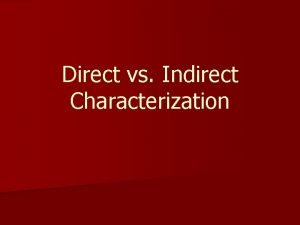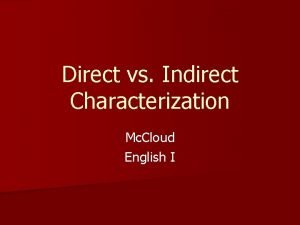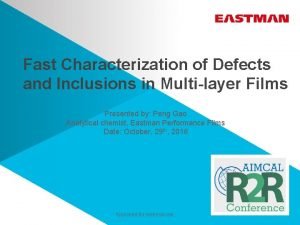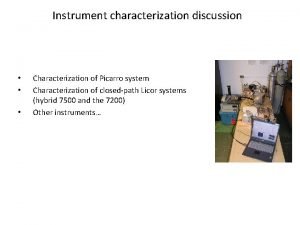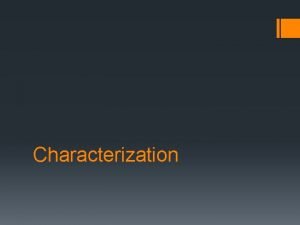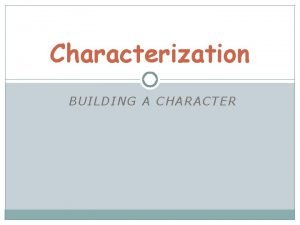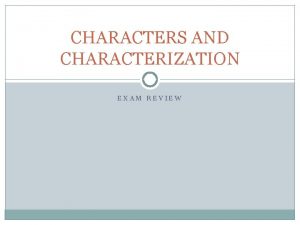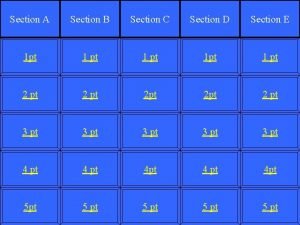1 Section 4 Characterization u u u Characterization














- Slides: 14

1 Section 4 - Characterization u u u Characterization is 95% of the Success of ISCO Develop a complete and comprehensive Conceptual Site Model ISCO is a Mass Destruction Technology Successful Treatment must Identify both target and non target analytes and contain all phases of Mass Know Flow paths within soil Structure

2 Conceptual Site Model Development First and most important step in remediation project includes u Characterization of nature and mass of contaminants present • Sorbed • Dissolved • Free product phases u u Subsurface geology, site topography, aquifer geochemistry Identification of major migration pathways for contaminants of concern (COC) • Surface and subsurface structures • Underground utilities u u Direction / gradient / velocity of groundwater flow Surface water features / uses, and potential receptors in the area

Contaminant Mass PSH, Sorbed, Dissolved 3 Appl. Well • Existing MW Total VOCs (average for all Areas) ppm TPH/Cosolvents ppm Total Contaminant Load Area 1 - 850 100 x 75 ppm TIC ppm Number of Wells 10 Area 2 - 300 x 130 (includes Area 1) 35 0 Area 3 - 185 x 125 20 Multiply the number of wells times the reagent requirement 0 850

4 Total Mass Evaluation Nature of Contamination u Contamination mass exists in four phases in the contaminated zone • • u u Soil gas Sorbed Dissolved Non-aqueous phase liquid (NAPL) or phase-separated Graphic source: Suthersan, 1996 Geochemistry, partitioning coefficient (Kow) determines the relationship between phases in the saturated zone Majority of mass (normally >80%) is sorbed and phase-separated

5 Total Mass Evaluation Importance of Mass Calculations u u Evaluate pre- and post- total contaminant mass Sorbed and non-aqueous phase mass converts to dissolved during treatment and until site reaches post treatment final equilibrium Possible “rebound” causes • Dissolution of sorbed or non-aqueous phase • Inadequate site characterization • Change in groundwater flow direction Decrease in total mass may not be reflected in short-term dissolved concentrations Electroconductivity Diagram

6 Treatment Volume Estimate • Clean. OX Appl. Well Existing MW Radius of Influence ft 20 Area of Influence sft 1258 Screen Depth, top ft 5 Screen Depth, bot. ft 30 Total Treatment Volume cft 31450 Total Groundwater Volume gal 70583 Total Groundwater Weight lb 588744

7 Value of Data Quantity vs. Certified Analytical Data u u ISCO requires contaminant delineation, precise concentration data quality not as critical as for closure confirmation References – available at www. itrcweb. org under “Guidance Documents” • ITRC Technical and Regulatory Guidance for the Triad Approach: A New Paradigm for Environmental Project Management (SCM-1, December 2003) • ITRC Strategies for Monitoring the Performance of DNAPL Source Zone Remedies (DNAPLs-5, August 2004)

8 Site Geochemistry/Geology Units Value Range Limits % 0. 3 Permeability md 3574. 237 1 - 10, 000 p. H s. u. 6. 5 <8. 5 u. S/cm 500 0 F 65 32 - 130 0. 02 0. 0001 - 0. 2 Site Geochemistry/Geology • Porosity Specific conductance Groundwater temperature Groundwater velocity ft/day Notes 100 - 6000

9 Oxidant Demand Nomenclature u u u Natural oxidant demand (NOD) Soil oxidant demand (SOD) Total oxidant demand (TOD) Natural organic matter (NOM) Standard laboratory measurements of oxidizable matter in groundwater include • Chemical oxygen demand (COD) • Total organic carbon (TOC) • Total inorganic carbon (TIC)

10 Site Geochemistry/Geology Units Value Range Limits m. V 0 70 - (-70) Grain size mm 0. 07 Dissolved oxygen (DO) ppm 4 0. 01 - 25 TDS ppm 500 50 - 1500 TOC in groundwater ppm 4 <40 Hydroxyl scavenger ppm 100 <400 • Redox potential (ORP) Well diameter inch 11/2 Notes 10% pt. new SS

11 Conditions that Require Special Consideration u u u u Low permeable soils Deep aquifers LNAPL/DNAPL Confined formations Swamps or high organic soils Old landfills and dumps River embankments Under buildings

12 Special Site Model Considerations No Utilities I-55 L imited Acce ss Hig h way Private Property Access Only Pipeline Flood Prone Area with Dirt Roads Surface Water Body

13 Lithology and Flow Path u u Borings need to be properly installed by experienced personnel, which is contrary to reimbursement program pricing Fine Sand lenses and variations in permeability are difficult to determine with Geoprobe programs Wells need to be properly screened and developed (not three well volumes as in PST programs) Confining layers are critical

14 Conceptual Site Model Target Interval Identification Target Interval Contaminant Mass Soil Conductivity
 Direct characterization meaning
Direct characterization meaning Indirect characterization
Indirect characterization Concept mapping chapter 10 meiosis 1 and meiosis 2
Concept mapping chapter 10 meiosis 1 and meiosis 2 Sectional view examples
Sectional view examples Example of section view
Example of section view Section 2 describing energy worksheet answers
Section 2 describing energy worksheet answers Enumerate the types of revolve section view
Enumerate the types of revolve section view Type of characterization
Type of characterization Dynamic characters in pride and prejudice
Dynamic characters in pride and prejudice What does indirect characterization mean
What does indirect characterization mean Direct vs indirect characterization
Direct vs indirect characterization Of mice and men curley's wife drawing
Of mice and men curley's wife drawing Direct vs. indirect characterization
Direct vs. indirect characterization Lamb to the slaughter plot diagram
Lamb to the slaughter plot diagram Fast characterization
Fast characterization










